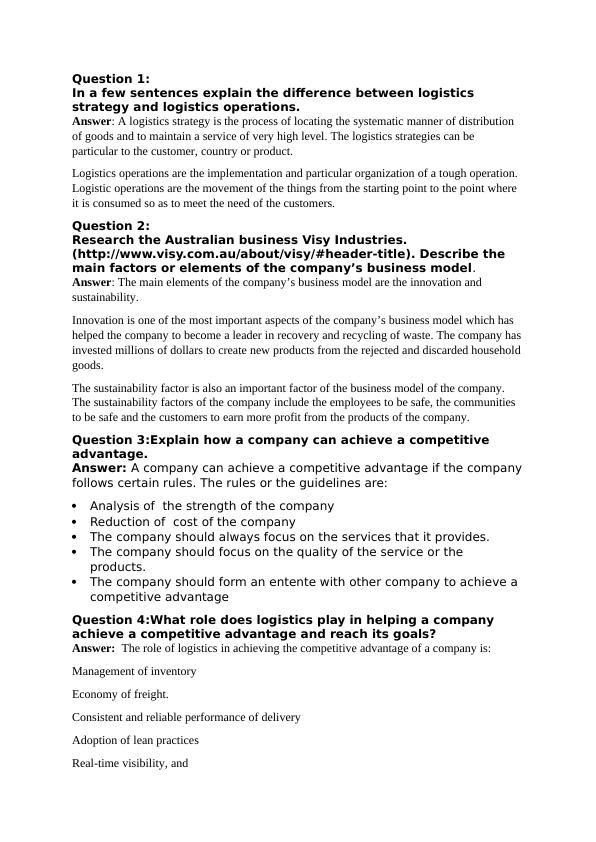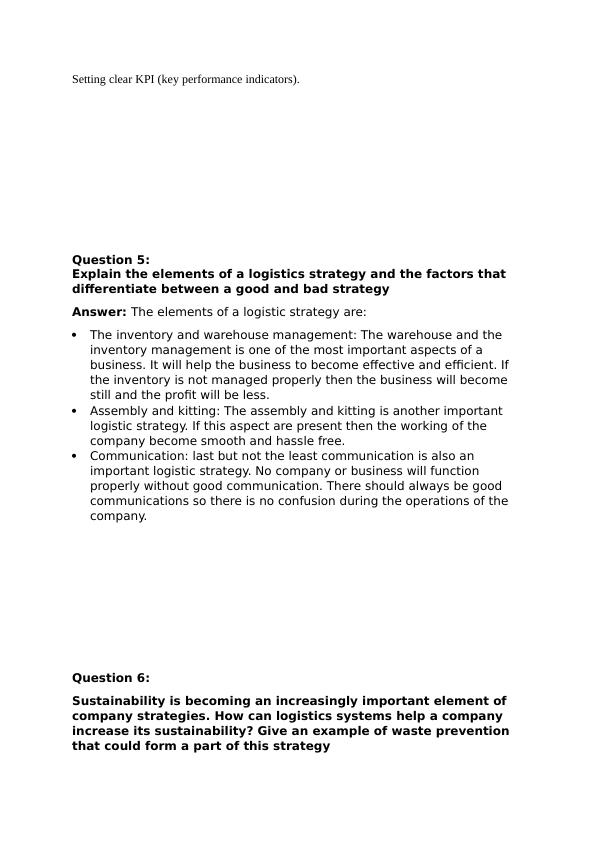Logistics Strategy and Operations: Differences and Importance
Added on 2022-11-13
8 Pages2015 Words347 Views
Question 1:
In a few sentences explain the difference between logistics
strategy and logistics operations.
Answer: A logistics strategy is the process of locating the systematic manner of distribution
of goods and to maintain a service of very high level. The logistics strategies can be
particular to the customer, country or product.
Logistics operations are the implementation and particular organization of a tough operation.
Logistic operations are the movement of the things from the starting point to the point where
it is consumed so as to meet the need of the customers.
Question 2:
Research the Australian business Visy Industries.
(http://www.visy.com.au/about/visy/#header-title). Describe the
main factors or elements of the company’s business model.
Answer: The main elements of the company’s business model are the innovation and
sustainability.
Innovation is one of the most important aspects of the company’s business model which has
helped the company to become a leader in recovery and recycling of waste. The company has
invested millions of dollars to create new products from the rejected and discarded household
goods.
The sustainability factor is also an important factor of the business model of the company.
The sustainability factors of the company include the employees to be safe, the communities
to be safe and the customers to earn more profit from the products of the company.
Question 3:Explain how a company can achieve a competitive
advantage.
Answer: A company can achieve a competitive advantage if the company
follows certain rules. The rules or the guidelines are:
Analysis of the strength of the company
Reduction of cost of the company
The company should always focus on the services that it provides.
The company should focus on the quality of the service or the
products.
The company should form an entente with other company to achieve a
competitive advantage
Question 4:What role does logistics play in helping a company
achieve a competitive advantage and reach its goals?
Answer: The role of logistics in achieving the competitive advantage of a company is:
Management of inventory
Economy of freight.
Consistent and reliable performance of delivery
Adoption of lean practices
Real-time visibility, and
In a few sentences explain the difference between logistics
strategy and logistics operations.
Answer: A logistics strategy is the process of locating the systematic manner of distribution
of goods and to maintain a service of very high level. The logistics strategies can be
particular to the customer, country or product.
Logistics operations are the implementation and particular organization of a tough operation.
Logistic operations are the movement of the things from the starting point to the point where
it is consumed so as to meet the need of the customers.
Question 2:
Research the Australian business Visy Industries.
(http://www.visy.com.au/about/visy/#header-title). Describe the
main factors or elements of the company’s business model.
Answer: The main elements of the company’s business model are the innovation and
sustainability.
Innovation is one of the most important aspects of the company’s business model which has
helped the company to become a leader in recovery and recycling of waste. The company has
invested millions of dollars to create new products from the rejected and discarded household
goods.
The sustainability factor is also an important factor of the business model of the company.
The sustainability factors of the company include the employees to be safe, the communities
to be safe and the customers to earn more profit from the products of the company.
Question 3:Explain how a company can achieve a competitive
advantage.
Answer: A company can achieve a competitive advantage if the company
follows certain rules. The rules or the guidelines are:
Analysis of the strength of the company
Reduction of cost of the company
The company should always focus on the services that it provides.
The company should focus on the quality of the service or the
products.
The company should form an entente with other company to achieve a
competitive advantage
Question 4:What role does logistics play in helping a company
achieve a competitive advantage and reach its goals?
Answer: The role of logistics in achieving the competitive advantage of a company is:
Management of inventory
Economy of freight.
Consistent and reliable performance of delivery
Adoption of lean practices
Real-time visibility, and

Setting clear KPI (key performance indicators).
Question 5:
Explain the elements of a logistics strategy and the factors that
differentiate between a good and bad strategy
Answer: The elements of a logistic strategy are:
The inventory and warehouse management: The warehouse and the
inventory management is one of the most important aspects of a
business. It will help the business to become effective and efficient. If
the inventory is not managed properly then the business will become
still and the profit will be less.
Assembly and kitting: The assembly and kitting is another important
logistic strategy. If this aspect are present then the working of the
company become smooth and hassle free.
Communication: last but not the least communication is also an
important logistic strategy. No company or business will function
properly without good communication. There should always be good
communications so there is no confusion during the operations of the
company.
Question 6:
Sustainability is becoming an increasingly important element of
company strategies. How can logistics systems help a company
increase its sustainability? Give an example of waste prevention
that could form a part of this strategy
Question 5:
Explain the elements of a logistics strategy and the factors that
differentiate between a good and bad strategy
Answer: The elements of a logistic strategy are:
The inventory and warehouse management: The warehouse and the
inventory management is one of the most important aspects of a
business. It will help the business to become effective and efficient. If
the inventory is not managed properly then the business will become
still and the profit will be less.
Assembly and kitting: The assembly and kitting is another important
logistic strategy. If this aspect are present then the working of the
company become smooth and hassle free.
Communication: last but not the least communication is also an
important logistic strategy. No company or business will function
properly without good communication. There should always be good
communications so there is no confusion during the operations of the
company.
Question 6:
Sustainability is becoming an increasingly important element of
company strategies. How can logistics systems help a company
increase its sustainability? Give an example of waste prevention
that could form a part of this strategy

Ans: There are different ways that can improve the performance of the
logistics systems:
Reduction of the Emission
The job of the transportation industry includes the transportation of
the goods from one area to another area. Industry should the
priority of the reduction of the carbon emission of the carbon. Many
vehicles are running on the fuels which are made up of the fossil.
The implantation of the green solution is the most efficient way of
reducing the pollution.
Reducing the amount of the waste products
In the transport industry the primary cost is the fuel cost. The
vehicle contains the many parts. The gallons of oil, and minimum
four tiers are required for driving of the vehicle.
Reduction of the amount energy which is consumed
The amount of the energy is used by the shipper that reflects the
sustainability of the logistics. If the shipper is using the faster mode
of the transport then it will affect the environment greatly.
Question 7:
There is an International Risk Management Standard; Refer to
https://www.iso.org/obp/ui#iso:std:iso:31000:ed-2:v1:en URL
“The ISO 31000:2018 Risk Management – Principles and
guidelines” and examine Figure 1 on the front page. You will
notice a 3-stage process map that outlines the various factors of
Risk Management.
• On the right-hand side of the figure (Process
Clause 6) there is a list of processes that a logistics manager
should perform to be compliant.
List the 6 steps in the risk management process.
Ans: The six steps in the risk management process are:
Communication and consulting, Recording and reporting, monitoring and
review, Scope context and criteria, Risk assessment and risk treatment.
Thinking about the Visy Industries again, imagine you are
the transport manager for collection of recycled cardboard.
List 4 potential risks that need to be closely managed to
minimize an accident in the Visy supply chain.
logistics systems:
Reduction of the Emission
The job of the transportation industry includes the transportation of
the goods from one area to another area. Industry should the
priority of the reduction of the carbon emission of the carbon. Many
vehicles are running on the fuels which are made up of the fossil.
The implantation of the green solution is the most efficient way of
reducing the pollution.
Reducing the amount of the waste products
In the transport industry the primary cost is the fuel cost. The
vehicle contains the many parts. The gallons of oil, and minimum
four tiers are required for driving of the vehicle.
Reduction of the amount energy which is consumed
The amount of the energy is used by the shipper that reflects the
sustainability of the logistics. If the shipper is using the faster mode
of the transport then it will affect the environment greatly.
Question 7:
There is an International Risk Management Standard; Refer to
https://www.iso.org/obp/ui#iso:std:iso:31000:ed-2:v1:en URL
“The ISO 31000:2018 Risk Management – Principles and
guidelines” and examine Figure 1 on the front page. You will
notice a 3-stage process map that outlines the various factors of
Risk Management.
• On the right-hand side of the figure (Process
Clause 6) there is a list of processes that a logistics manager
should perform to be compliant.
List the 6 steps in the risk management process.
Ans: The six steps in the risk management process are:
Communication and consulting, Recording and reporting, monitoring and
review, Scope context and criteria, Risk assessment and risk treatment.
Thinking about the Visy Industries again, imagine you are
the transport manager for collection of recycled cardboard.
List 4 potential risks that need to be closely managed to
minimize an accident in the Visy supply chain.

End of preview
Want to access all the pages? Upload your documents or become a member.
Related Documents
Value Chain Concept and Competitive Advantage: A Case Study of Challenger Limitedlg...
|21
|4730
|454
Value Chain Model for Tesco Organizationlg...
|10
|2757
|56
Logistics and Supply Chain Managementlg...
|15
|3027
|240
Logistic Systems at Red Cross Society | Reportlg...
|28
|7987
|15
Red Cross- Disaster Logistics Volunteerlg...
|26
|7128
|14
Logistics and Supply Chain Management (Doc)lg...
|10
|1501
|73
